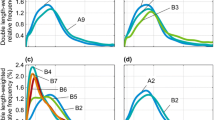Abstract
A confocal laser scanning microscope (CLSM) was used to investigate the distribution and penetration of urea-melamine-formaldehyde (UMF) resin in the fiber when injected through blowline blending in a medium density fiberboard (MDF) pilot plant. Samples were prepared with respect to industrial parameters and were collected at the dryer’s end. The samples were later dyed in a Dye Star-Brilliant Red solution (0.01%) and rinsed with distilled water to remove excess. The samples were scanned with the CLSM to build three-dimensional reconstructions of MDF fiber cross-sections. With proper lenses and optimized CLSM settings, it was possible to obtain fiber reconstructions with a resolution greater than the laser wave length (514 nm). The Zeiss CLSM built-in software image analyzer enabled to rebuild them in rotation on any of the three axes with up to 64 images per rotation. The resin penetration sites were identified using this software option. The penetration sites were numerous and well dispersed. The largest openings (lumen, pits and cracks) were responsible for most of the resin lost by over-penetration. The presence of resin in the cell walls (detected with the CLSM) proves their porosity without giving much information about the resin concentration. Finally, the atomic force microscope (AFM) enabled to recreate the finest surface details for these fibers samples. It was found that the fibrils aggregates orientation and size can influence the resin penetration and distribution.
It was concluded that the porous structure of wood fibers and their affinity to water enable the resin to penetrate through capillary force. This phenomenon is stimulated by the high pressure, saturated steam, turbulent flow and heat. When injected in the pilot plant blowline, UMF resin was uniformly distributed over the fiber surface (22.5% coverage). The resin penetration was however important and also occurred in nanometric defaults of the wood fibers. Thus, industrial panels made out of very porous, damaged or small fibers will need more resin to fill the gaps in order to make a strong board.
Zusammenfassung
Mit Hilfe eines konfokalen Laserscanning-Mikroskops (CLSM) wurde die Verteilung und Eindringung von Harnstoff-Melamin-Formaldehydharz (UMF) in die Holzfasern bei einer Beleimung mit dem Blowline-Verfahren in einer Versuchsanlage untersucht. Die Proben wurden wie in der Praxis üblich hergestellt und nach dem Trocknen entnommen. Danach wurden die Proben in einer Dye Star-Brillant Red Lösung (0.01%) gebleicht und zur Entfernung von Rückständen mit destilliertem Wasser gespült. Zur dreidimensionalen Rekonstruktion von MDF-Faserquerschnitten wurden die Proben mit dem CLSM gescannt. Mittels geeigneter Linsen und optimalen CLSM-Einstellungen war es möglich, die Fasern mit einer höheren Auflösung als der Laserwellenlänge (514 nm) zu rekonstruieren. Mit der eingebauten CLSM Bildanalyse-Software von Zeiss konnten die Fasern unter einem beliebigen Winkel dargestellt werden. Damit konnten die zahlreichen und gut verteilten Eindringstellen des Harzes bestimmt werden. Die größten Öffnungen (Lumen, Tüpfel und Risse) waren aufgrund der großen Eindringmenge überwiegend für den Harzverlust verantwortlich. Das Auftreten von Harz in den Zellwänden (mit dem CLSM bestimmt) belegt deren Porosität, wobei nur wenig Aussagen zur Harzkonzentration möglich sind. Mit dem Rasterkraftmikroskop (AFM) konnten die kleinsten Oberflächendetails für diese Faserproben nachgebildet werden. Es stellte sich heraus, dass die Richtung und die Größe der Fibrillenaggregate das Eindringen und die Verteilung von Harz beeinflussen können.
Daraus lässt sich schließen, dass das Harz wegen der porösen Struktur der Holzfasern und deren Wasseraffinität aufgrund von Kapillarkräften eindringen kann. Hoher Druck, gesättigter Dampf, turbulente Strömung und Wärme tragen dazu bei. Beim Einsprühen in die Blowline-Versuchsanlage verteilte sich das UMF-Harz gleichmäßig über die Faseroberfläche (22.5% Abdeckung). Einen großen Einfluss hatte die Eindringung auch in kleine Öffnungen im Nanobereich. Folglich benötigen industriell hergestellte Platten aus sehr porösen, beschädigten oder kleinen Fasern mehr Harz, um die Lücken zu füllen und um eine stabile Platte herstellen zu können.
Similar content being viewed by others
References
Abe K, Yamamoto H (2005) Mechanical interaction between cellulose microfibril and matrix substance in wood cell wall determined by X-Ray diffraction. J Wood Sci 51:334–338
Cyr PL, Riedl B, Wang XM, Groom L (expected to be published in 2008) Atomic force microscopy of refined spruce fibers (Picea spp.). Wood Sci Technol
Cyr PL, Riedl B, Wang XM, Shaler S (2006) Urea-melamine-formaldehyde (UMF) resin penetration in medium-density fiberboard (MDF) wood fibers. Adh Sci Technol 20:787–801
Donaldson LA, Lomax TD (1989) Adhesive/fibre interaction in medium density fibreboard. Wood Sci Technol 23:371–380
Gindl W, Dessipri E, Wimmer R (2002) Using UV-Microscopy to study diffusion of melamine-urea-formaldehyde resin in cell walls of spruce wood. Holzforschung 56:103–107
Grigsby W, Thumm A (2004) Visualisation of UF resin on MDF fibre by XPS imaging. Holz Roh- Werkst 62:365–369
Murmanis L, Myers GC, Youngquist JA (1986) Fluorescence microscopy of hardboards. Wood Fiber Sci 18(2):212–219
Pakdel H, Cyr PL, Riedl B, Deng J (2007) Quantification of urea formaldehyde resin in wood fibers using X-ray photoelectron spectroscopy and confocal laser scanning microscopy. Wood Sci Technol DOI 10.1007/s00226-007-0155-4
Rapp AO, Bestgen H, Adam W, Peek RD (1999) Electron energy loss spectroscopy (EELS) for quantification of cell-wall penetration of melamine resin. Holzforschung 53:111–117
Saariaho AM, Jääskeläinen AS, Matousek P, Towrie M, Parker AW, Vuorinen T (2004) Resonance Raman spectroscopy of highly fluorescing lignin containing chemical pulps: Suppression of the fluorescence with an optical Kerr gate. Holzforschung 58:82–90
Thumm A, Mc Donald AG, Donaldson LA (2001) Visualisation of UF resin in MDF cathodoluminescence/scanning electron microscopy. Holz Roh- Werkst 59:215–216
Xing C (2003) Characterisation of urea-formaldehyde resin efficiency affected by four factors in the manufacture of medium density fiberboard, PhD Thesis, Université Laval, Québec
Author information
Authors and Affiliations
Corresponding author
Rights and permissions
About this article
Cite this article
Cyr, PL., Riedl, B. & Wang, XM. Investigation of Urea-Melamine-Formaldehyde (UMF) resin penetration in Medium-Density Fiberboard (MDF) by High Resolution Confocal Laser Scanning Microscopy . Holz Roh Werkst 66, 129–134 (2008). https://doi.org/10.1007/s00107-007-0216-2
Published:
Issue Date:
DOI: https://doi.org/10.1007/s00107-007-0216-2




